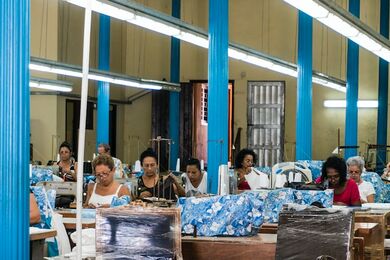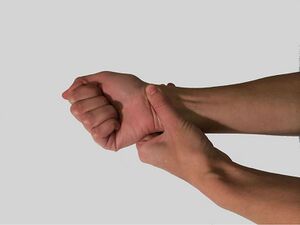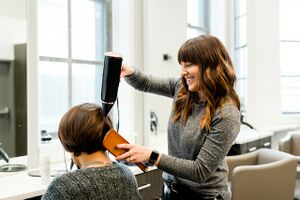Work-Related Musculoskeletal Injuries and Prevention: Difference between revisions
Yuan Chuang (talk | contribs) (Add pictures) |
m (Nupur Smit Shah moved page Work-Related Neck and Upper Limb Musculoskeletal Disorders to Work-Related Musculoskeletal Injuries and Prevention: merging page) |
||
| (8 intermediate revisions by 3 users not shown) | |||
| Line 1: | Line 1: | ||
<div class="editorbox"> | <div class="editorbox"> | ||
<br>'''Top Contributors''' - {{Special:Contributors/{{FULLPAGENAME}}}} | |||
</div> | |||
== Introduction == | |||
[[File:Factory workers.jpeg|thumb|Risky postures at work|alt=|390x390px]] | |||
[[File:Builder.jpeg|right|frameless]] | |||
[[Work-Related Musculoskeletal Disorders|Work-related musculoskeletal injuries]] (WRMI), or work-related musculoskeletal disorders (WMSD), are any range of inflammatory disorders resulting from injury sustained while completing work duties<ref>McLeod G, Murphy M, Henare T, Dlabik B. Work-related musculoskeletal injuries among Australian osteopaths: A preliminary investigation. International Journal of Osteopathic Medicine. 2018;27:14-22. </ref>. WMSDs are: | |||
# The result of regular exposure to work activities that contribute significantly to the development or exacerbation of painful symptoms | |||
# Conditions that are worsened or that persist due to work conditions<ref name=":0">Work-Related Musculoskeletal Disorders & Ergonomics | Workplace Health Strategies by Condition | Workplace Health Promotion | CDC [Internet]. Cdc.gov. 2020 [cited 26 April 2020]. Available from: <nowiki>https://www.cdc.gov/workplacehealthpromotion/health-strategies/musculoskeletal-disorders/index.html</nowiki></ref>. | |||
Such can be the result of repetitive and frequent work activities resulting in overuse and strain to nerves, ligaments, muscles, tendons, joints, and spinal discs<ref name=":1">Work-related Musculoskeletal Disorders (WMSDs) : OSH Answers [Internet]. Ccohs.ca. 2020 [cited 26 April 2020]. Available from: <nowiki>https://www.ccohs.ca/oshanswers/diseases/rmirsi.html</nowiki></ref>. | |||
= | These disorders are also commonly referred to as repetitive strain injuries, cumulative trauma disorders, and overuse syndrome, among others. Due to the emphasis on upper extremity use in occupational tasks, the vast majority of WRMIs impact the hands, wrists, elbows, shoulders and neck; however, conditions involving the lower extremities and feet, as well as spine and back are common<ref name=":1" />.WMSDs do not include conditions caused by slips, trips, [[falls]], or related injuries, whether or not sustained in the workplace<ref name=":0" />. | ||
[[ | |||
Prophylactic practices by workers such as strength training, stretching, yoga, massages, and diet maintenance, are the superior treatment for musculoskeletal injury.<ref>Zhao R, Rothchild E, Wang F, Nash D, Greige N, Lala B, Ricci JA. Prevalence, Prevention, and Treatment of Work-Related Musculoskeletal Disorders Among Microsurgeons. Journal of Reconstructive Microsurgery. 2022 Oct 11.Available:https://pubmed.ncbi.nlm.nih.gov/36220105/ (accessed 25.10.2022)</ref> | |||
For a comprehensive delve into this topic read [[Introduction to Occupational Health]] and partake in the [https://members.physio-pedia.com/learn/occupational-health-programme/?utm_source=physiopedia&utm_medium=content_ad_GE16&utm_campaign=growth_experiments Occupational Health Programme] | |||
[[ | |||
== WMSDs Categories == | |||
WMSDs can be broadly broken down into three categories: | |||
# Muscle injury | |||
# Tendon injury | |||
# Nerve injury. Common types of WMSDs include [[Carpal Tunnel Syndrome|carpal tunnel syndrome (CTS)]], tendonitis, [[Thoracic Outlet Syndrome (TOS)|thoracic outlet syndrome (TOS)]], and [[Prevention and Management of Occupational Related LBP|back pain]]<ref name=":1" />. | |||
Watch this good 6 minute video on WMSD's.{{#ev:youtube|L6zQ80gBdyU}}<ref>Therapy-First Physiotherapy Ltd. Musculoskeletal Disorders & Work Place [Internet]. 2013 [cited 26 April 2020]. Available from: <nowiki>https://youtu.be/L6zQ80gBdyU</nowiki></ref> | |||
== | == Importance of Ergonomics == | ||
Work-related musculoskeletal disorders and their associated high costs are a large concern in the workplace. To reduce potential occupational injuries, a safe working environment must be created, and all workers must understand, accept, and use the principles of ergonomics.<ref name=":2">Science direct WRMDs Available:https://www.sciencedirect.com/topics/medicine-and-dentistry/work-related-musculoskeletal-disorder (accessed 25.10.2022)</ref> | |||
== Who’s at risk for developing WMSD? == | |||
[[File:Butchery.jpeg|thumb|375x375px|Butchery]] | |||
Industries with high rates of WMSDs include meatpacking, knit-underwear manufacturing, motor vehicle manufacturing, poultry processing, mail and message distribution, construction, butchery, food processing, machine operation, dental hygiene and dentistry, data entry, hand grinding and polishing, carpentry, industrial truck and tractor operation, nursing assistance, housecleaning, and, worldwide, agriculture.<ref name=":2" /> | |||
==== General Risk Factor ==== | |||
[[File:Farm workers.jpeg|thumb|Heavy physical work a risk factor]] | |||
Work posture (especially awkward or improper posture)<ref name=":1" /> | |||
* Heavy physical work | |||
* Lifting | |||
* Repetitive, labor-intensive work | |||
* Vibration (via hand tools) | |||
* Temperature extremes (low temperature) | |||
* Individual risk factors including smoking, high BMI, and presence of co-morbidities<ref>da Costa B, Vieira E. Risk factors for work-related musculoskeletal disorders: a systematic review of recent longitudinal studies. American Journal of Industrial Medicine. 2009;.</ref> | |||
==== Organizational Risk Factors ==== | |||
* | * Lack of influence or control over one's job | ||
* | * Being subjected to verbal abuse, or sexual harassment, at work | ||
==== Risk Factors Specific to the Healthcare Setting ==== | |||
*[[File:Hospital workers overworked.jpeg|thumb|Hospital workers overworked?]]Lifting patients or equipment | |||
*Transferring patients | |||
*Responding to unexpected movement | |||
*Manual therapy | |||
*Failure to take rest breaks | |||
*Inadequate staffing | |||
*Inadequate training on injury prevention | |||
=== Psychosocial Risk Factors === | |||
*Low work content | |||
*Low social support | |||
*High perceived work load | |||
*Time pressure | |||
*Low job control | |||
*Perceived stress | |||
*High psychological stresses | |||
*Providing domestic work | |||
*Unsatisfactory leisure activities <ref name="p1">The chartered society of physiotherapy. Employment relations and union services:health & safety –work-related strain injuries (musculoskeletal).www.csp.org.uk. Accessed June 2011.</ref><ref name="p4">Fredriksson K, Alfredson L, Koster M , et al. Risk factors for neck and upper limb disorders: results from 24 years of follow up. Occup Enviorn Med. 1999;56.59-66.</ref> | |||
* | === External Risk Factors === | ||
** | [[File:Production line work.jpeg|thumb|High productivity demands- a risk factor]]'''Low Back''' | ||
* | *Small workspace | ||
*High productivity demands | |||
*Understaffing | |||
*Pt’s size, condition, shape, assisting during gait, confused/agitated | |||
*Unadjustable beds/mats/chairs/commodes | |||
*Repetitive bending, twisting, lifting<ref name="p1" /><ref name="p4" /><ref name="p7">Daynard D, Yassi A, Cooper J E, et al. Biomechanical analysis of peak and cumulative spinal loads during simulated patient-handling activities: a substudy of a randomized controlled trial to prevent lift and transfer injury of health care workers. Applied Ergonomics. 2001;32. 199-214.</ref> <ref name="p8">Garg A, Owen B, Beller D and Banaag. A biomechanical and ergonomic evaluation of patient transferring tasks: bed to wheelchair and wheelchair to bed. Ergonomics. 1991;34 (3). 289-312.</ref> | |||
'''Neck/Upper Back/Shoulder''' | |||
*Type A personality | |||
*Scheduling | |||
*Rest breaks | |||
*Work-load: OverTime, high work-load | |||
*Repetitiveness | |||
*Manual techniques | |||
*High mental load eg Hectic work environment, exhaustion at end of day | |||
*Blue collar work (Male) <ref name="p1" /><ref name="p4" /> <ref name="p6">Holte K, Westgaard R. Daytime trapezius muscle activity and shoulder-neck pain of service workers with wors stress and low biomechanical exposure. Amer Jour of Industrial Med. 2002; 41. 393-405.</ref><br> | |||
[[File:Overuse, wrist symptoms.jpeg|thumb|Overuse symptoms in wrist]]'''Hand and Wrist''' | |||
*High volume of manual therapy | |||
*Static positioning of a joint - decreased blood flow to area | |||
*Sustained duration pressure through a joint | |||
*Small, unsupported joints | |||
*High work load | |||
*Scheduling/decreased rest breaks <ref name="Frye">Frye, Barbara. "Hand and Wrist." Body Mechanics for Manual Therapists: a Functional Approach to Self-care. Philadelphia: Wolters Kluwer/Lippincott Williams & Wilkins, 2010. Print.</ref> | |||
=== Internal Risk Factors === | |||
[[File:Hairdressers - awkward work positions.jpeg|thumb|Hairdressers have ergonomic issues]] | |||
'''Low Back''' | |||
*Female: Height and weight less than male counterparts, pregnancy, increased stresses on body and increased ligamentous laxity | |||
*Psychosocial Health, stress | |||
*Lack of experience, uncomfortable requesting assistance | |||
*Postural Stresses, eg stooping<ref name="p1" /><ref name="p4" /><ref name="p7" /><ref name="p8" /> | |||
[[File:Chris-benson-yx-iJFybOBQ-unsplash.jpg|thumb|Forward head posture]] | |||
'''Neck/Upper Back/Shoulders''' | |||
* [[Forward Head Posture|Forward head posture]] | |||
*Volume of pressing is greater than pulling - i.e. weaker posterior musculature | |||
*Lack of stability through trunk and hips | |||
*Age | |||
*Smoking | |||
*Mental stress | |||
*Previous injury | |||
*Unhealthy BMI<ref name="p1" /><ref name="p4" /> | |||
====Wrist and Hand ==== | |||
*MCP is more commonly injured in younger therapists | |||
*CMC is more commonly injured in older therapists | |||
*Increased CMC joint laxity | |||
*Decreased tip pinch strength | |||
*Decreased Body Mass Index (BMI)<ref name="wajon">Wajon, A., and L. Ada. "Prevalence of Thumb Pain in Physical Therapists Practicing Spinal Manipulative Therapy." Journal of Hand Therapy 16.3 (2003): 237-44. Print.</ref> | |||
== Consequences of Injuries == | |||
# Personal : Depression. Anger. Early signs of aging due to stress. Potential negative effects on family or relationship | |||
# Work-Related: Leave work Absentee Worker’s Compensation Lost productivity Retraining of staff | |||
# Economical Costs: The '''direct costs '''of an injury are the easiest to see and understand. These costs '''include''' <u>emergency room and doctor visits, medical bills, medicines, and rehabilitation</u>. '''Indirect costs '''of an injury are often overlooked. These costs can amount up to 4 times the direct cost of the injury. Indirect costs '''include''' <u>administrative time dealing with the injury and medical care, raises in insurance costs, replacing the hours lost of the injured employee with hiring another employee, loss of reputation and confidence in employees and clients, unwanted media attention, and more</u>. The '''total costs '''of an injury are suprising. Beyond the direct costs, the indirect costs greatly increase the overall costs. This is the '''true amount that the injury will cost''' in terms of money.<ref name="p1" /><ref name="p3">Boocok M G, McNair P J, Larmer P J, et al. Intervention for the prevention and management of neck/upper extremity musculoskeletal conditions: a systematic review. Occup Enviorn Med. 2007.;64. 291-303.</ref> | |||
== Prevention of Injuries == | |||
=== Risk Assessment === | |||
*'''Employer’s responsibility''' | |||
**Eliminate or minimize work hazards | |||
**encourage open discussion among employees regarding injury and prevention | |||
*'''To include (but not limited to):''' | |||
**Minimal lifting approach | |||
**Knowledge/training on proper use of equipment | |||
**Adequate staffing | |||
**Re-evaluating content and frequency of training courses | |||
***Especially w/ younger/newly hired PT’s | |||
***Training programs have little effect without <u>aggressive ergonomic evaluation</u> | |||
**PT available for staff<ref name="p1" /> | |||
=== Training === | |||
*"...bodymechanics and back-care training are valid elements of injury prevention programs, but only when combined with an ergonomic approach..." -Owen and Garg | |||
*"To help prevent shoulder injuries, employers should conduct a worksite evaluation, consider feasible control measures and train employees"<ref name="p2">Yassi A, Cooper JE, Tate RB, et al. A randomized controlled trial to prevent patient lift and transfer injuries of health care workers. Spine. 2001.;26 (16) 1739-1746.</ref> | |||
*"Integrating your entire body, using your body's weight, proper joint alignment, and a variety of movements will help develop dynamic body mechanics ensuring the successful use of your hands." - Barbara Frye<ref name="p7" /><ref name="Frye" /> | |||
==== Custom Training <ref name="p3" /> ==== | |||
*'''Bio-mechanic and ergonomical training, lifting and manual handling with hand/body as main tool, safe use of equipment, effects sustained postures, caseload variation, work organization, working with other professionals''' | |||
*'''Include Cognitive Behavioral Theory''' | |||
**Activity Pacing | |||
***Scheduling activities | |||
**Attention Diversion | |||
***Distracting patient | |||
**Cognitive Restructuring | |||
***Identify and restructure dysfunctional thoughts and emotions | |||
**Goal Setting | |||
***Patient-centered | |||
**Graded Exposure | |||
***Gradual systematic progression | |||
**Maintenance Strategies | |||
***Plan to manage flare-ups | |||
**Problem-solving Strategies | |||
***Define problem and how you are going to solve the problem | |||
*'''Prompted “micro” breaks''' | |||
**Leads to increased work productivity | |||
*'''However … risk reducing behaviors without immediate benefit are often NOT perceived as beneficial'''<ref name="p3" /> | |||
====Body Mechanics ==== | |||
Spinal Compression is a result of trunk extensor activation along with ligaments and discs trying to support the force from Lumbar spine up. According to NIOSH (National Institute for Occupational Safety and Health) spinal compression >3400N puts a person at risk of low back injury; with a maximum permissible limit of 6400N. When comparing 3 different (unspecified) lifting techniques, Gagnon et al. estimated compressive forces to be 5744-7951N at the L5/S1 disc space. This estimate exceeds the limit of risk but also exceeds the permissible limit defined by NIOSH.<ref name="p7" /><ref name="p8" /><ref name="p5">Garg A, Sharma D, Chaffin D, et al. Biomechanical stresses as related to motion trajectory of lifting. The human factors society. 1983;25 (5). 527-539.</ref> | |||
====Lifting Techniques ==== | |||
See [[Lifting|Liftin]]<nowiki/>g | |||
== Prevention/Intervention Strategies == | |||
*'''Reporting Injuries''' | |||
**Makes the problem less invisible --> increase workplace safety | |||
*'''Implementing mandatory “micro” rest breaks throughout the day''' | |||
*'''Managing/Coping with stress''' | |||
*'''Footwear''' | |||
*'''Use your entire body when possible, especially large muscles that are meant to take the load''' | |||
*'''Exercise''' | |||
**Increase core/trunk strength | |||
**Flexibility | |||
**Endurance | |||
**Mid and Lower Trap, Rotator Cuff | |||
*'''Warming up prior''' | |||
**Stairs, walking ~5 min | |||
**Stretching/Going through the motions before a transfer/lift/manual therapy | |||
*'''Maintain Healthy Weight/Lifestyle''' | |||
*'''Posture Checks throughout day''' | |||
**Sitting, standing, patient care | |||
*'''Ask for help''' | |||
**Work as a team (Co-treats) | |||
*'''Use your whole body when performing manual therapy instead of just your upper extremities''' | |||
*'''Use of Assistive Devices (including but not limited to)<ref name="p3" />:''' | |||
*Battery operated lifts (hoyer lifts) | |||
*Gait belts | |||
*Draw sheets and friction reducing sheet<ref name="p4" /><ref name="p1" /><br /> | |||
== References == | == References == | ||
<references /> | <references /> | ||
[[Category:Occupational Health]] | |||
[[Category:Musculoskeletal/Orthopaedics]] | [[Category:Musculoskeletal/Orthopaedics]] | ||
[[Category: | [[Category:Global Health]] | ||
Latest revision as of 11:33, 18 July 2023
Top Contributors - Yuan Chuang, Nupur Smit Shah and Kim Jackson
Introduction[edit | edit source]
Work-related musculoskeletal injuries (WRMI), or work-related musculoskeletal disorders (WMSD), are any range of inflammatory disorders resulting from injury sustained while completing work duties[1]. WMSDs are:
- The result of regular exposure to work activities that contribute significantly to the development or exacerbation of painful symptoms
- Conditions that are worsened or that persist due to work conditions[2].
Such can be the result of repetitive and frequent work activities resulting in overuse and strain to nerves, ligaments, muscles, tendons, joints, and spinal discs[3].
These disorders are also commonly referred to as repetitive strain injuries, cumulative trauma disorders, and overuse syndrome, among others. Due to the emphasis on upper extremity use in occupational tasks, the vast majority of WRMIs impact the hands, wrists, elbows, shoulders and neck; however, conditions involving the lower extremities and feet, as well as spine and back are common[3].WMSDs do not include conditions caused by slips, trips, falls, or related injuries, whether or not sustained in the workplace[2].
Prophylactic practices by workers such as strength training, stretching, yoga, massages, and diet maintenance, are the superior treatment for musculoskeletal injury.[4]
For a comprehensive delve into this topic read Introduction to Occupational Health and partake in the Occupational Health Programme
WMSDs Categories[edit | edit source]
WMSDs can be broadly broken down into three categories:
- Muscle injury
- Tendon injury
- Nerve injury. Common types of WMSDs include carpal tunnel syndrome (CTS), tendonitis, thoracic outlet syndrome (TOS), and back pain[3].
Watch this good 6 minute video on WMSD's.
Importance of Ergonomics[edit | edit source]
Work-related musculoskeletal disorders and their associated high costs are a large concern in the workplace. To reduce potential occupational injuries, a safe working environment must be created, and all workers must understand, accept, and use the principles of ergonomics.[6]
Who’s at risk for developing WMSD?[edit | edit source]
Industries with high rates of WMSDs include meatpacking, knit-underwear manufacturing, motor vehicle manufacturing, poultry processing, mail and message distribution, construction, butchery, food processing, machine operation, dental hygiene and dentistry, data entry, hand grinding and polishing, carpentry, industrial truck and tractor operation, nursing assistance, housecleaning, and, worldwide, agriculture.[6]
General Risk Factor[edit | edit source]
Work posture (especially awkward or improper posture)[3]
- Heavy physical work
- Lifting
- Repetitive, labor-intensive work
- Vibration (via hand tools)
- Temperature extremes (low temperature)
- Individual risk factors including smoking, high BMI, and presence of co-morbidities[7]
Organizational Risk Factors[edit | edit source]
- Lack of influence or control over one's job
- Being subjected to verbal abuse, or sexual harassment, at work
Risk Factors Specific to the Healthcare Setting[edit | edit source]
- Lifting patients or equipment
- Transferring patients
- Responding to unexpected movement
- Manual therapy
- Failure to take rest breaks
- Inadequate staffing
- Inadequate training on injury prevention
Psychosocial Risk Factors [edit | edit source]
- Low work content
- Low social support
- High perceived work load
- Time pressure
- Low job control
- Perceived stress
- High psychological stresses
- Providing domestic work
- Unsatisfactory leisure activities [8][9]
External Risk Factors[edit | edit source]
Low Back
- Small workspace
- High productivity demands
- Understaffing
- Pt’s size, condition, shape, assisting during gait, confused/agitated
- Unadjustable beds/mats/chairs/commodes
- Repetitive bending, twisting, lifting[8][9][10] [11]
Neck/Upper Back/Shoulder
- Type A personality
- Scheduling
- Rest breaks
- Work-load: OverTime, high work-load
- Repetitiveness
- Manual techniques
- High mental load eg Hectic work environment, exhaustion at end of day
- Blue collar work (Male) [8][9] [12]
Hand and Wrist
- High volume of manual therapy
- Static positioning of a joint - decreased blood flow to area
- Sustained duration pressure through a joint
- Small, unsupported joints
- High work load
- Scheduling/decreased rest breaks [13]
Internal Risk Factors[edit | edit source]
Low Back
- Female: Height and weight less than male counterparts, pregnancy, increased stresses on body and increased ligamentous laxity
- Psychosocial Health, stress
- Lack of experience, uncomfortable requesting assistance
- Postural Stresses, eg stooping[8][9][10][11]
Neck/Upper Back/Shoulders
- Volume of pressing is greater than pulling - i.e. weaker posterior musculature
- Lack of stability through trunk and hips
- Age
- Smoking
- Mental stress
- Previous injury
- Unhealthy BMI[8][9]
Wrist and Hand[edit | edit source]
- MCP is more commonly injured in younger therapists
- CMC is more commonly injured in older therapists
- Increased CMC joint laxity
- Decreased tip pinch strength
- Decreased Body Mass Index (BMI)[14]
Consequences of Injuries[edit | edit source]
- Personal : Depression. Anger. Early signs of aging due to stress. Potential negative effects on family or relationship
- Work-Related: Leave work Absentee Worker’s Compensation Lost productivity Retraining of staff
- Economical Costs: The direct costs of an injury are the easiest to see and understand. These costs include emergency room and doctor visits, medical bills, medicines, and rehabilitation. Indirect costs of an injury are often overlooked. These costs can amount up to 4 times the direct cost of the injury. Indirect costs include administrative time dealing with the injury and medical care, raises in insurance costs, replacing the hours lost of the injured employee with hiring another employee, loss of reputation and confidence in employees and clients, unwanted media attention, and more. The total costs of an injury are suprising. Beyond the direct costs, the indirect costs greatly increase the overall costs. This is the true amount that the injury will cost in terms of money.[8][15]
Prevention of Injuries[edit | edit source]
Risk Assessment[edit | edit source]
- Employer’s responsibility
- Eliminate or minimize work hazards
- encourage open discussion among employees regarding injury and prevention
- To include (but not limited to):
- Minimal lifting approach
- Knowledge/training on proper use of equipment
- Adequate staffing
- Re-evaluating content and frequency of training courses
- Especially w/ younger/newly hired PT’s
- Training programs have little effect without aggressive ergonomic evaluation
- PT available for staff[8]
Training[edit | edit source]
- "...bodymechanics and back-care training are valid elements of injury prevention programs, but only when combined with an ergonomic approach..." -Owen and Garg
- "To help prevent shoulder injuries, employers should conduct a worksite evaluation, consider feasible control measures and train employees"[16]
- "Integrating your entire body, using your body's weight, proper joint alignment, and a variety of movements will help develop dynamic body mechanics ensuring the successful use of your hands." - Barbara Frye[10][13]
Custom Training [15][edit | edit source]
- Bio-mechanic and ergonomical training, lifting and manual handling with hand/body as main tool, safe use of equipment, effects sustained postures, caseload variation, work organization, working with other professionals
- Include Cognitive Behavioral Theory
- Activity Pacing
- Scheduling activities
- Attention Diversion
- Distracting patient
- Cognitive Restructuring
- Identify and restructure dysfunctional thoughts and emotions
- Goal Setting
- Patient-centered
- Graded Exposure
- Gradual systematic progression
- Maintenance Strategies
- Plan to manage flare-ups
- Problem-solving Strategies
- Define problem and how you are going to solve the problem
- Activity Pacing
- Prompted “micro” breaks
- Leads to increased work productivity
- However … risk reducing behaviors without immediate benefit are often NOT perceived as beneficial[15]
Body Mechanics[edit | edit source]
Spinal Compression is a result of trunk extensor activation along with ligaments and discs trying to support the force from Lumbar spine up. According to NIOSH (National Institute for Occupational Safety and Health) spinal compression >3400N puts a person at risk of low back injury; with a maximum permissible limit of 6400N. When comparing 3 different (unspecified) lifting techniques, Gagnon et al. estimated compressive forces to be 5744-7951N at the L5/S1 disc space. This estimate exceeds the limit of risk but also exceeds the permissible limit defined by NIOSH.[10][11][17]
Lifting Techniques[edit | edit source]
See Lifting
Prevention/Intervention Strategies[edit | edit source]
- Reporting Injuries
- Makes the problem less invisible --> increase workplace safety
- Implementing mandatory “micro” rest breaks throughout the day
- Managing/Coping with stress
- Footwear
- Use your entire body when possible, especially large muscles that are meant to take the load
- Exercise
- Increase core/trunk strength
- Flexibility
- Endurance
- Mid and Lower Trap, Rotator Cuff
- Warming up prior
- Stairs, walking ~5 min
- Stretching/Going through the motions before a transfer/lift/manual therapy
- Maintain Healthy Weight/Lifestyle
- Posture Checks throughout day
- Sitting, standing, patient care
- Ask for help
- Work as a team (Co-treats)
- Use your whole body when performing manual therapy instead of just your upper extremities
- Use of Assistive Devices (including but not limited to)[15]:
- Battery operated lifts (hoyer lifts)
- Gait belts
- Draw sheets and friction reducing sheet[9][8]
References[edit | edit source]
- ↑ McLeod G, Murphy M, Henare T, Dlabik B. Work-related musculoskeletal injuries among Australian osteopaths: A preliminary investigation. International Journal of Osteopathic Medicine. 2018;27:14-22.
- ↑ 2.0 2.1 Work-Related Musculoskeletal Disorders & Ergonomics | Workplace Health Strategies by Condition | Workplace Health Promotion | CDC [Internet]. Cdc.gov. 2020 [cited 26 April 2020]. Available from: https://www.cdc.gov/workplacehealthpromotion/health-strategies/musculoskeletal-disorders/index.html
- ↑ 3.0 3.1 3.2 3.3 Work-related Musculoskeletal Disorders (WMSDs) : OSH Answers [Internet]. Ccohs.ca. 2020 [cited 26 April 2020]. Available from: https://www.ccohs.ca/oshanswers/diseases/rmirsi.html
- ↑ Zhao R, Rothchild E, Wang F, Nash D, Greige N, Lala B, Ricci JA. Prevalence, Prevention, and Treatment of Work-Related Musculoskeletal Disorders Among Microsurgeons. Journal of Reconstructive Microsurgery. 2022 Oct 11.Available:https://pubmed.ncbi.nlm.nih.gov/36220105/ (accessed 25.10.2022)
- ↑ Therapy-First Physiotherapy Ltd. Musculoskeletal Disorders & Work Place [Internet]. 2013 [cited 26 April 2020]. Available from: https://youtu.be/L6zQ80gBdyU
- ↑ 6.0 6.1 Science direct WRMDs Available:https://www.sciencedirect.com/topics/medicine-and-dentistry/work-related-musculoskeletal-disorder (accessed 25.10.2022)
- ↑ da Costa B, Vieira E. Risk factors for work-related musculoskeletal disorders: a systematic review of recent longitudinal studies. American Journal of Industrial Medicine. 2009;.
- ↑ 8.0 8.1 8.2 8.3 8.4 8.5 8.6 8.7 The chartered society of physiotherapy. Employment relations and union services:health & safety –work-related strain injuries (musculoskeletal).www.csp.org.uk. Accessed June 2011.
- ↑ 9.0 9.1 9.2 9.3 9.4 9.5 Fredriksson K, Alfredson L, Koster M , et al. Risk factors for neck and upper limb disorders: results from 24 years of follow up. Occup Enviorn Med. 1999;56.59-66.
- ↑ 10.0 10.1 10.2 10.3 Daynard D, Yassi A, Cooper J E, et al. Biomechanical analysis of peak and cumulative spinal loads during simulated patient-handling activities: a substudy of a randomized controlled trial to prevent lift and transfer injury of health care workers. Applied Ergonomics. 2001;32. 199-214.
- ↑ 11.0 11.1 11.2 Garg A, Owen B, Beller D and Banaag. A biomechanical and ergonomic evaluation of patient transferring tasks: bed to wheelchair and wheelchair to bed. Ergonomics. 1991;34 (3). 289-312.
- ↑ Holte K, Westgaard R. Daytime trapezius muscle activity and shoulder-neck pain of service workers with wors stress and low biomechanical exposure. Amer Jour of Industrial Med. 2002; 41. 393-405.
- ↑ 13.0 13.1 Frye, Barbara. "Hand and Wrist." Body Mechanics for Manual Therapists: a Functional Approach to Self-care. Philadelphia: Wolters Kluwer/Lippincott Williams & Wilkins, 2010. Print.
- ↑ Wajon, A., and L. Ada. "Prevalence of Thumb Pain in Physical Therapists Practicing Spinal Manipulative Therapy." Journal of Hand Therapy 16.3 (2003): 237-44. Print.
- ↑ 15.0 15.1 15.2 15.3 Boocok M G, McNair P J, Larmer P J, et al. Intervention for the prevention and management of neck/upper extremity musculoskeletal conditions: a systematic review. Occup Enviorn Med. 2007.;64. 291-303.
- ↑ Yassi A, Cooper JE, Tate RB, et al. A randomized controlled trial to prevent patient lift and transfer injuries of health care workers. Spine. 2001.;26 (16) 1739-1746.
- ↑ Garg A, Sharma D, Chaffin D, et al. Biomechanical stresses as related to motion trajectory of lifting. The human factors society. 1983;25 (5). 527-539.















